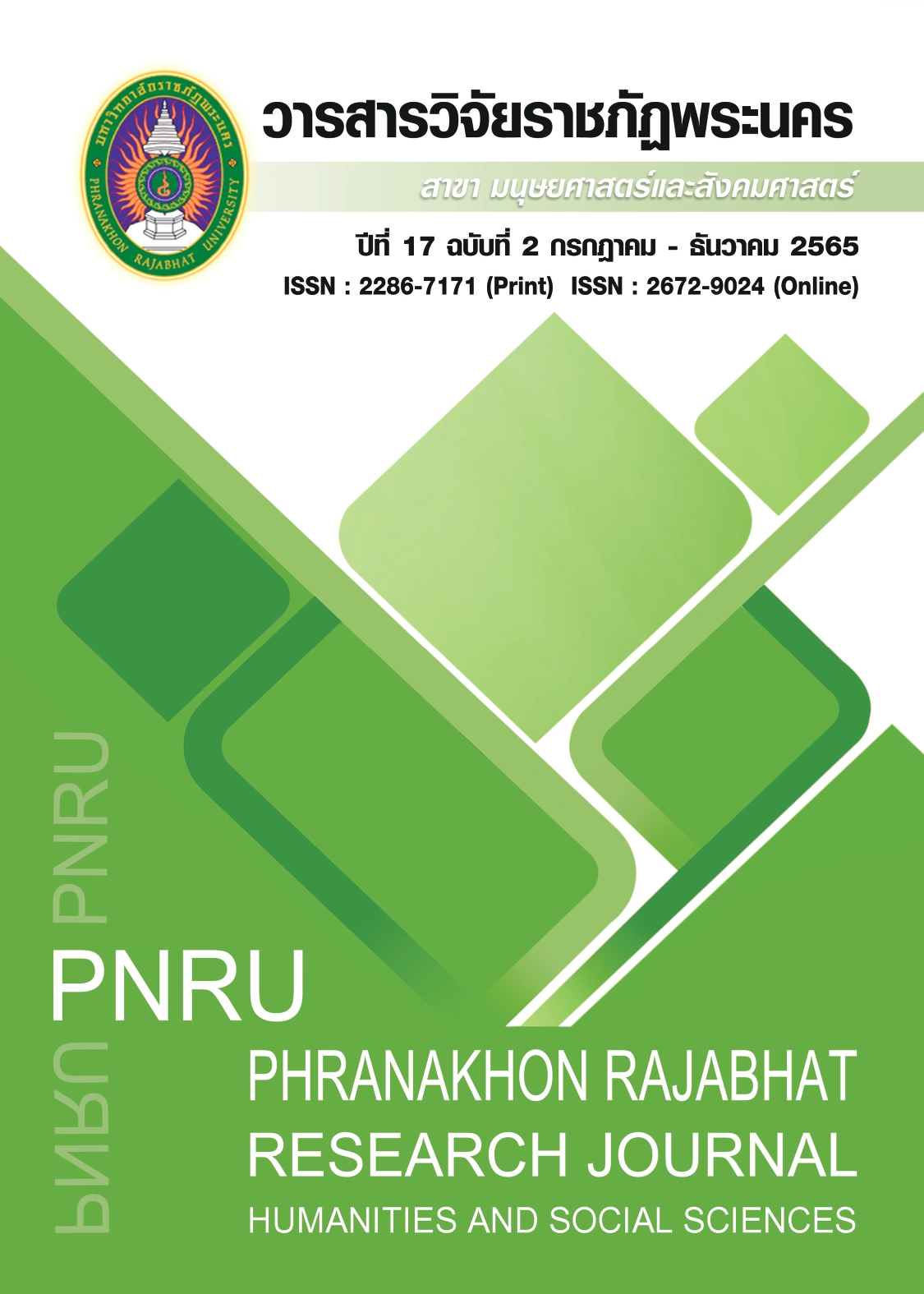SYNTACTIC STRUCTURES AND SEMANTIC DENOTATIONS OF GERUNDS IN BIOGRAPHICAL TEXTS
Main Article Content
Abstract
Have you ever been asked who your role model is in your life? What did he/she do that impressed you? This study investigated how verbal gerunds are used in biographical texts in English. The study also investigated the linguistic perspectives on syntactic structures and semantic denotation. Previous research papers focused on the use of gerunds in English newspapers, literature, and international corpora. However, this study fills the gap by contributing to the view of biographical texts. As mentioned in previous studies, verbal gerunds denote factual events. It is intriguing to investigate whether these semantic denotations are applied to biographical texts, where the genre of writing has a mixture of narrative writing and a history of someone’s life. The materials in this study are the biographical texts of Queen Elizabeth II, the late Prince Philip, Duke of Edinburgh, and the late Princess Dianna, since they are the best-sellers (amazon.com). The study includes 41 sentences extracted from the material, containing a total of 300,000 words. The data validation follows the Index of Item Objective Congruence (IOC), where three experts, being English instructors, were asked to validate the data analysis. The results of this study show that the use of gerunds is explained by various linguistic perspectives. Syntactically, the use of gerunds is equivalent to the DP subject, which is coreferential with a higher clause (Radford, 2009). The semantic denotations of gerunds in biographical texts indicate simultaneous events. It is hoped that this study will be beneficial for learners of English as a Second Language (ESL) and English as a Foreign Language (EFL) to write biographical texts systematically and interestingly.
Article Details

This work is licensed under a Creative Commons Attribution-NonCommercial-NoDerivatives 4.0 International License.
Each publish articles were copyright by Phranakorn Rajabhat University
Any contents which appeared in each articles in the journal were authors personal opinion. It did not relate to Phranakorn Rajabhat University and other instructors in the university. Each authors would take responsibility on their articles. If there are any mistake, the authors will take responsibility themselves
References
Brandreth, G. (2021). Philip: The Final Portrait. London: Mobius.
Brown, T. (2017). Remembering Diana: A life in Photographs. London: National Geographic.
Connelly, F. & Clandinin, D. J. (1987). On narrative method, biography and narrative unities in the study of teaching. The Journal of Educational Thought, 21(3). 130-139.
Dirven, R., & Verspoor, M. (2004). Cognitive Exploration of Language and Linguistics. Amsterdam/Philadelphia: John Benjamin Publishing.
Dolby, K. (2019. Queen Elizabeth II’s guide to life. UK: Michael O’s Mara.
Duffley, P. J., & Arseneau, M. (2012). Tense and control interpretations in gerund participle and to- infinitive complement constructions with verbs of risk. Canadian Journal of Linguistics, 57(1), 31-50.
Hakim, K. F., Widodo, S., & Nugraeni, I. I. (2021). The Analysis of Gerunds in The Adventure of Sherlock Holmes. Scripta: English Department Journal, 8(1), 32-38.
Heyvaert, L., Maekelberghr, C., & Buyle, A. (2016). Nominal and verbal gerunds in Present-day English: Aspectual features and nominal status. Leuven Working Paper in Linguistics, 211-243.
Heyvaert, L., Maekelberghe, C., & Buyle, A. (2019). Nominal and verbal gerunds in present-day English: Aspectual feature and nominal status, Language Sciences, 73, 32-49.
Hollmann, W. B. (2003). Synchrony and diachrony of English periphrastic causatives: A cognitive perspective. Manchester: University of Manchester PhD dissertation.
Hundt, M. (2009). Colonial lag, colonial innovation or simple language change. Gunter Rohdenburg & Julia Schluer (eds.). In One language two grammar?: Differences between British and American. Cambridge: Cambridge University Press.
Kaplan, J. (1978). The real life. Danial Aaron: In Studies in Biography. USA: Harvard University Press.
Mostafa, S. (2019). Developing the EFL advanced learners’ narrative writing skills through a unite plan strategy. CDELT Occasional Papers in the Development of English Education, 68(1), 323-356
Radford, A. (2009). Introduction to English sentence structure. Cambridge: Cambridge University Press.
Radden, G., & Dirven, R. (2007). Cognitive English grammar. Amsterdam/ Philadelphia: John Benjamin Publishing.
Rai, N., & Thapa, B. (2015). A study on purposive sampling method in ResearchKathmandu: Kathmandu School of Law, 5, 1-12.
Rudanko, J. (1989). Complementation and Case Grammar: A Syntactic and Semantic
Study of Selected Patterns of Complementation in Present-Day English. New York: State University of New York Press.
Swan, M. (2016). Practical English usage. Oxford: Oxford University Press.
Trudgill, P. (1999). A window on the past: "Colonial lag" and New Zealand evidence for the phonology of nineteenth-century English. American Speech, 734(3), 227-239.
Traugott, E. C. (2010). (Inter)subjectivity and Intersubjectification: a reassessment”. Kristin
Davidse, Lieven Vandelanotte & Hubert Cuyken (eds.). In Subjectification, intersubjectification and grammaticalization (pp. 29-73). Berlin & New York: De Gruyter Mouton.
Wang, D. (2014). Verbs taking “to+v” or “v+ing” as their complements: A cognitive grammar account. International Journal of Linguistics, 6(5), 143-153.
Widyawati, W.Y. (2018). An analysis of students’ errors by using gerunds by the fourth semester on English Department. TELL-US Journal, 4(2), 16-27.
Wongkittiporn, A., & Chitrakara, N. (2018). Control Constructions in British and American English. Bulletin of the Transilvania University of Brasov, Series IV, Philology and Cultural Studies, 11(60), 19-48.
Wurmbrand, S. (2014). Tense and aspect in English infinitives. Linguistic Inquiry, 45(3), 403-447.
Yilmaz, A. (2018). Form-meaning-use framework in grammar teaching: Research on Noun clauses in writing skills. Journal of Language and Linguistic Studies, 14(3). 37-55.
Yule, G. (2006). The study of language. Cambridge: Cambridge University Press.


